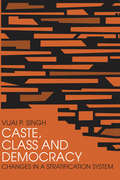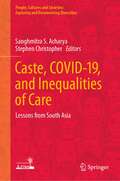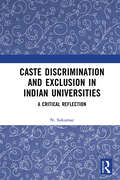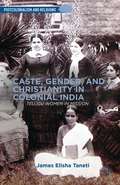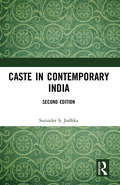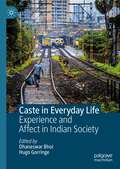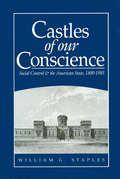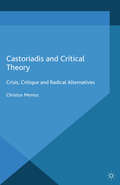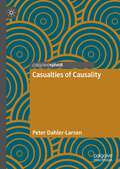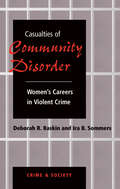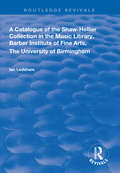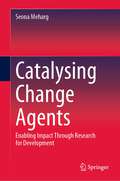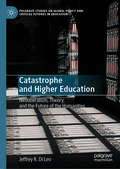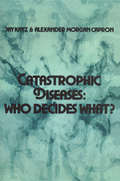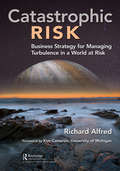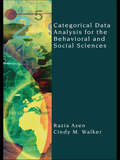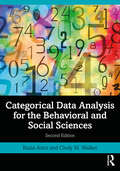- Table View
- List View
Caste, Class and Democracy
by Vijai P. SinghThis volume is an introduction to the role of caste and class in Indian society, meant to emphasize certain important aspects of Indian society such as continuity and change in caste, economic classes, status of women, status of Harijans, village poli-tics, overseas Indians, and casteism and tribalism. Its theoretical interest is to explain the dynamics of social inequalities in Indian society.All but one of the essays are based on research conducted in India. The other is based on research on Indian plantation workers in Sri Lanka, and included here to demonstrate that the concepts of caste and class are relevant to understanding In-dians who have emigrated to overseas countries.
Caste, COVID-19, and Inequalities of Care: Lessons from South Asia (People, Cultures and Societies: Exploring and Documenting Diversities)
by Sanghmitra S. Acharya Stephen ChristopherThis book explores how social discrimination in South Asia contributes to health disparities and impedes well-being. Specifically, it addresses how marginalization shapes health outcomes, both under normal circumstances and specifically during the COVID-19 pandemic. Coming from diverse backgrounds and representing different academic disciplines, the authors have contributed a range of chapters drawing from quantitative and ethnographic material across South Asia. Chapters address reservation politics, tribal lifeways, Dalit exclusions from governmental institutions, Muslim ghettoization, gendered domestic violence, social determinants of health among migrant workers, and the pandemic fallout across South Asian society, among other subjects. Scholars draw on decades of experience and firsthand ethnographic fieldwork among affected communities. The chapters provide an innovative analysis, often in real time, of the human toll of casteism, classism, patriarchy, and religious intolerance—many set against the spectre of COVID-19. Many authors not only present social critiques but also offer specific policy recommendations. The book is of great interest to social scientists, public health practitioners, and policy advocates interested in addressing systemic inequalities and ensuring that future pandemics are not disproportionately felt by the most vulnerable.
Caste Discrimination and Exclusion in Indian Universities: A Critical Reflection
by N. SukumarThis book studies the exclusion and discrimination that is meted out to Scheduled Caste (SC) students in the Indian Higher Education system, and the psychosocial consequences of such practices. It foregrounds the conceptual debates around caste, exclusion, and reservations in Indian academia, discussing the social dominance and the roots of prejudices in the university spaces. The volume reflects upon the fragile social world in which students from the margins struggle for survival in the academic space. It reveals that these students navigate the various facets of academia – like classrooms, pedagogy, scholarships, hostels, peer groups, and teachers – only to find the academic space a dystopian universe. The book also sheds light on suicide cases committed by the marginalized groups as a testimony of protest. Based on in-depth ethnographic research, this book will be of interest to teachers, students and researchers of education, sociology, political science, psychology, and exclusion studies. It will also be useful for policymakers, social activists, NGOs, research centers, and those working in higher education, reservations, public policy, caste, and exclusion studies.
Caste Discrimination and Exclusion in Indian Universities: A Critical Reflection
by N. SukumarThis book studies the exclusion and discrimination that is meted out to Scheduled Caste (SC) students in the Indian Higher Education system, and the psychosocial consequences of such practices. It foregrounds the conceptual debates around caste, exclusion, and reservations in Indian academia, discussing the social dominance and the roots of prejudices in the university spaces. The volume reflects upon the fragile social world in which students from the margins struggle for survival in the academic space. It reveals that these students navigate the various facets of academia – like classrooms, pedagogy, scholarships, hostels, peer groups, and teachers – only to find the academic space a dystopian universe. The book also sheds light on suicide cases committed by the marginalized groups as a testimony of protest. Based on in-depth ethnographic research, this book will be of interest to teachers, students and researchers of education, sociology, political science, psychology, and exclusion studies. It will also be useful for policymakers, social activists, NGOs, research centers, and those working in higher education, reservations, public policy, caste, and exclusion studies.
Caste, Gender, and Christianity in Colonial India: Telugu Women in Mission (Postcolonialism and Religions)
by J. TanetiBeginning in the nineteenth century, native women preachers served and led nascent Protestant churches in much of Southern India, evolving their own mission theology and practices. This volume examines the impact of Telugu socio-political dynamics, such as caste, gender, and empire, on the theology and practices of the Telugu Biblewomen.
Caste in Contemporary India
by Surinder S. JodhkaCaste is a contested terrain in India’s society and polity. This book explores contemporary realities of caste in rural and urban India. It examines questions of untouchability, citizenship, social mobility, democratic politics, corporate hiring and Dalit activism. Using rich empirical evidence from the field across Punjab, Uttar Pradesh, Delhi and other parts of north India, this volume presents the reasons for the persistence of caste in India from a new perspective. The book offers an original theoretical framework for comparative understandings of the entrenched social differences, discrimination, inequalities, stratification, and the modes and patterns of their reproduction. This second edition, with a new Introduction, delves into why caste continues to matter and how caste-based divisions often tend to overlap with the emergent disparities of the new economy. A delicate balance of lived experience and hard facts, this persuasive work will serve as essential reading for students and teachers of sociology and social anthropology, social exclusion and discrimination studies, political science, development studies and public policy.
Caste in Contemporary India
by Surinder S. JodhkaCaste is a contested terrain in India’s society and polity. This book explores contemporary realities of caste in rural and urban India. It examines questions of untouchability, citizenship, social mobility, democratic politics, corporate hiring and Dalit activism. Using rich empirical evidence from the field across Punjab, Uttar Pradesh, Delhi and other parts of north India, this volume presents the reasons for the persistence of caste in India from a new perspective. The book offers an original theoretical framework for comparative understandings of the entrenched social differences, discrimination, inequalities, stratification, and the modes and patterns of their reproduction. This second edition, with a new Introduction, delves into why caste continues to matter and how caste-based divisions often tend to overlap with the emergent disparities of the new economy. A delicate balance of lived experience and hard facts, this persuasive work will serve as essential reading for students and teachers of sociology and social anthropology, social exclusion and discrimination studies, political science, development studies and public policy.
Caste in Everyday Life: Experience and Affect in Indian Society
by Dhaneswar Bhoi Hugo GorringeThis edited volume brings together a range of scholars to reflect on the varied ways in which caste is manifested and experienced in social life. Each chapter draws on different methods and approaches but all consider lived experiences and experiential narrations. Considering Guru and Sarukkai’s path-breaking work on ‘Experience, Caste and the Everyday Social’ (2019), this volume applies the insights of the theories to multiple settings, issues and communities. Unique to this volume, Brahmin and other dominant castes' experiences are considered, rather than simply focusing on the lives of oppressed castes (Dalits). Analysis of cross-caste friendships or romances and marriages, furthermore, brings out the intimate and ingrained aspects of caste. Taken together, therefore, the contributions in this volume offer rich insights into caste and its consciousness within the framework of everyday experiences.
Castles of our Conscience: Social Control and the American State 1800 - 1985
by William G. StaplesCastles of our Conscience presents a new and distinctive analysis of the role of the modern state in the shaping of policies of social control. Staples provides a theoretical framework for understanding the mechanisms of state policy-making and capacity. This framework supports an interpretation of the changing nature of institutions of social control in the United States from the beginning in the nineteenth century to the present day. A distinctive feature of the author’s approach is his critique of existing theories of the state as well as recent revisionist writing in social control. Both, he argues, have tended to either reduce the state to an instrument of class power or treat it in too ‘structuralist’ a fashion. Developing a sophisticated account of the relationship between the state and civil society he provides a history of social control policies in the United States that balances analytical concerns with historical narrative. This book will be of interest to students and professionals in sociology, politics and criminology.
Castles of our Conscience: Social Control and the American State 1800 - 1985
by William G. StaplesCastles of our Conscience presents a new and distinctive analysis of the role of the modern state in the shaping of policies of social control. Staples provides a theoretical framework for understanding the mechanisms of state policy-making and capacity. This framework supports an interpretation of the changing nature of institutions of social control in the United States from the beginning in the nineteenth century to the present day. A distinctive feature of the author’s approach is his critique of existing theories of the state as well as recent revisionist writing in social control. Both, he argues, have tended to either reduce the state to an instrument of class power or treat it in too ‘structuralist’ a fashion. Developing a sophisticated account of the relationship between the state and civil society he provides a history of social control policies in the United States that balances analytical concerns with historical narrative. This book will be of interest to students and professionals in sociology, politics and criminology.
Castoriadis and Critical Theory: Crisis, Critique and Radical Alternatives
by Christos MemosBy exploring the concepts of 'crisis' and 'critique', this study offers a thought-provoking re-examination of the political and social thought of Cornelius Castoriadis in light of the current world crisis and with regard to his radical critique of both the traditional Left and contemporary capitalist societies.
Casualties of Causality
by Peter Dahler-LarsenThis book offers a critique of the present status of the concept of causality in the social sciences. “The Causality Syndrome” consists of a belief in causal studies as more important than other studies, a narrow definition of causality, and rules of thumb regarding how to make causal claims. The book argues that the present dominance of this syndrome has considerable downsides and presents a challenge to social science. The book dissects the many interconnected ideas which undergird this syndrome and offers an intellectual home for advanced students, researchers and others who are concerned about the present dominance of The Causality Syndrome. The book critically discusses whether “causality” deserves the central position in social science that its advocates desire. The text shows how methodological rules about causal inference are used to protect causal studies from critique, even in situations where these rules are not followed. It is argued that institutionalization of these rules as symbols of good and trustworthy social science is highly problematic and comes with a price. One of the casualties of causality is that there is less motivation to study complex and pressing issues in society which do not lend themselves to causal study designs. The sections are short. The argument unfolds in a lively, engaged form with examples from many fields, including public health, evaluation and organizational studies. The case examples include classical experiments as well as contemporary research, e.g. studies of the effectiveness of restrictions targeting the spread of coronavirus.
Casualties Of Community Disorder: Women's Careers In Violent Crime (Crime And Society Ser.)
by Deborah BaskinThis book provides a detailed account of the criminal careers of 170 women who committed violent street crimes in New York City, describing their entry into criminal activities, their development into persistent street criminals, and, for some, their eventual transition out of street crime.
A Catalogue of the Shaw-Hellier Collection (Routledge Revivals)
by Ian LedshamIn this compilation, first published in 1999, Ian Ledsham compiles an extensive catalogue of the Shaw-Hellier Collection, complete with diagrams regarding how we use text.
A Catalogue of the Shaw-Hellier Collection (Routledge Revivals)
by Ian LedshamIn this compilation, first published in 1999, Ian Ledsham compiles an extensive catalogue of the Shaw-Hellier Collection, complete with diagrams regarding how we use text.
Catalysing Change Agents: Enabling Impact Through Research for Development
by Seona MehargThis book provides an overview of the challenges and opportunities for creating positive systemic change through research for development projects, providing four real-world examples. Practical insights are offered on identifying and cultivating change agents through your projects and programs, increasing the likelihood of enduring success. Understanding and participating in these types of interventions enable researchers and practitioners to become better agents of change themselves.
Catastrophe and Higher Education: Neoliberalism, Theory, and the Future of the Humanities (Palgrave Studies on Global Policy and Critical Futures in Education)
by Jeffrey R. Di LeoThis book asks what it means to live in a higher educational world continuously tempered by catastrophe. Many of the resources for response and resistance to catastrophe have long been identified by thinkers ranging from Ralph Waldo Emerson and William James to H. G. Wells and Emanuel Haldeman-Julius. Di Leo posits that hope and resistance are possible if we are willing to resist a form of pessimism that already appears to be drawing us into its arms. Catastrophe and Higher Education argues that the future of the humanities is tied to the fate of theory as a form of resistance to neoliberalism in higher education. It also offers that the fate of the academy may very well be in the hands of humanities scholars who are tasked with either rejecting theory and philosophy in times of catastrophe—or embracing it.
Catastrophic Diseases: Who Decides What?
by Jay Katz Alexander Morgan CapronAn important contribution in the burgeoning literature relating to the delivery of medical care, and to the broader question of responsible decision-making in those social areas where tragic choices have to be made. The effort is an excellent example of research into, and therapy for, an important social process.
Catastrophic Diseases: Who Decides What?
by Jay Katz Alexander Morgan CapronAn important contribution in the burgeoning literature relating to the delivery of medical care, and to the broader question of responsible decision-making in those social areas where tragic choices have to be made. The effort is an excellent example of research into, and therapy for, an important social process.
Catastrophic Risk: Business Strategy for Managing Turbulence in a World at Risk
by Richard L. AlfredImagine that you are a corporate executive or small business owner in a midwestern city under water after weeks of extreme weather and drenching rainfall. Infrastructure has been damaged beyond repair, transportation arteries are closed, and your supply chain is broken. Families have been driven from homes, food and water are in short supply, and people are becoming unruly. Government agencies are not in a position to help. Declining revenue and partisan antipathy fueled by ideological differences have eroded confidence in government. The city is in total disrepair and unable to deliver desperately needed services. It is edging toward implosion and community leaders have turned to you for help. Catastrophe that would have been unthinkable in earlier times is a reality in a world coming out of pandemic and facing existential threats such as climate change, inequality and global conflict. Catastrophic Risk: Business Strategy for Managing Turbulence in a World at Risk challenges business to step up and assume a pivotal role with communities under stress due to prolonged exposure to risk. When powerful societal forces meet behavior that deters response to risk, the consequences of risk are exacerbated. The compounding effect of behavior on risk has opened an important role for business in mobilizing people and communities in times of crisis. It is a role that cannot be fulfilled, however, without purpose, strategy and plans sufficiently robust to overcome the threat of risk. To prosper in this environment, business will need to make a significant contribution to society as well as to deliver financial performance. For companies, this will mean involvement in community in ways that significantly depart from current practice. For leaders, it will mean new skills—contextual sensitivity, a greater understanding of behavioral dynamics, and enhanced capacity to relate to people on an emotive basis. This book is about the relationship between risk, societal forces and human behavior—a relationship informed by the sciences that is critically important for business. Its goal is two-fold: to bring catastrophic risk to the world of business and to further business engagement in service to the common good.
Catastrophic Risk: Business Strategy for Managing Turbulence in a World at Risk
by Richard L. AlfredImagine that you are a corporate executive or small business owner in a midwestern city under water after weeks of extreme weather and drenching rainfall. Infrastructure has been damaged beyond repair, transportation arteries are closed, and your supply chain is broken. Families have been driven from homes, food and water are in short supply, and people are becoming unruly. Government agencies are not in a position to help. Declining revenue and partisan antipathy fueled by ideological differences have eroded confidence in government. The city is in total disrepair and unable to deliver desperately needed services. It is edging toward implosion and community leaders have turned to you for help. Catastrophe that would have been unthinkable in earlier times is a reality in a world coming out of pandemic and facing existential threats such as climate change, inequality and global conflict. Catastrophic Risk: Business Strategy for Managing Turbulence in a World at Risk challenges business to step up and assume a pivotal role with communities under stress due to prolonged exposure to risk. When powerful societal forces meet behavior that deters response to risk, the consequences of risk are exacerbated. The compounding effect of behavior on risk has opened an important role for business in mobilizing people and communities in times of crisis. It is a role that cannot be fulfilled, however, without purpose, strategy and plans sufficiently robust to overcome the threat of risk. To prosper in this environment, business will need to make a significant contribution to society as well as to deliver financial performance. For companies, this will mean involvement in community in ways that significantly depart from current practice. For leaders, it will mean new skills—contextual sensitivity, a greater understanding of behavioral dynamics, and enhanced capacity to relate to people on an emotive basis. This book is about the relationship between risk, societal forces and human behavior—a relationship informed by the sciences that is critically important for business. Its goal is two-fold: to bring catastrophic risk to the world of business and to further business engagement in service to the common good.
Categorical Data Analysis for the Behavioral and Social Sciences
by Razia Azen Cindy M. WalkerFeaturing a practical approach with numerous examples, this book focuses on helping the reader develop a conceptual, rather than technical, understanding of categorical methods, making it a much more accessible text than others on the market. The authors cover common categorical analyses and emphasize specific research questions that can be addressed by each analytic procedure so that readers are able to address the research questions they wish to answer. To achieve this goal, the authors: Review the theoretical implications and assumptions underlying each of the procedures Present each concept in general terms and illustrate each with a practical example Demonstrate the analyses using SPSS and SAS and show the interpretation of the results provided by these programs. A "Look Ahead" section at the beginning of each chapter provides an overview of the material covered so that the reader knows what to expect. This is followed by one or more research questions that can be addressed using the procedure(s) covered in the chapter. A theoretical presentation of the material is provided and illustrated using realistic examples from the behavioral and social sciences. To further enhance accessibility, the new procedures introduced in the book are explicitly related to analytic procedures covered in earlier statistics courses, such as ANOVA and linear regression. Throughout each chapter the authors use practical examples to demonstrate how to obtain and interpret statistical output in both SPSS and SAS. Their emphasis on the relationship between the initial research question, the use of the software to carry out the analysis, and the interpretation of the output as it relates to the initial research question, allows readers to easily apply the material to their own research. The data sets for executing chapter examples using SAS Version 9.1.3 and/or IBM SPSS Version 18 are available on a book specific web site. These data sets and syntax allow readers to quickly run the programs and obtain the appropriate output. The book also includes both conceptual and analytic end-of-chapter exercises to assist instructors and students in evaluating the understanding of the material covered in each chapter. This book covers the most commonly used categorical data analysis procedures. It is written for those without an extensive mathematical background, and is ideal for graduate courses in categorical data analysis or cross-classified data analysis taught in departments of psychology, human development & family studies, sociology, education, and business. Researchers in these disciplines interested in applying these procedures to their own research will appreciate this book’s accessible approach.
Categorical Data Analysis for the Behavioral and Social Sciences
by Razia Azen Cindy M. WalkerFeaturing a practical approach with numerous examples, this book focuses on helping the reader develop a conceptual, rather than technical, understanding of categorical methods, making it a much more accessible text than others on the market. The authors cover common categorical analyses and emphasize specific research questions that can be addressed by each analytic procedure so that readers are able to address the research questions they wish to answer. To achieve this goal, the authors: Review the theoretical implications and assumptions underlying each of the procedures Present each concept in general terms and illustrate each with a practical example Demonstrate the analyses using SPSS and SAS and show the interpretation of the results provided by these programs. A "Look Ahead" section at the beginning of each chapter provides an overview of the material covered so that the reader knows what to expect. This is followed by one or more research questions that can be addressed using the procedure(s) covered in the chapter. A theoretical presentation of the material is provided and illustrated using realistic examples from the behavioral and social sciences. To further enhance accessibility, the new procedures introduced in the book are explicitly related to analytic procedures covered in earlier statistics courses, such as ANOVA and linear regression. Throughout each chapter the authors use practical examples to demonstrate how to obtain and interpret statistical output in both SPSS and SAS. Their emphasis on the relationship between the initial research question, the use of the software to carry out the analysis, and the interpretation of the output as it relates to the initial research question, allows readers to easily apply the material to their own research. The data sets for executing chapter examples using SAS Version 9.1.3 and/or IBM SPSS Version 18 are available on a book specific web site. These data sets and syntax allow readers to quickly run the programs and obtain the appropriate output. The book also includes both conceptual and analytic end-of-chapter exercises to assist instructors and students in evaluating the understanding of the material covered in each chapter. This book covers the most commonly used categorical data analysis procedures. It is written for those without an extensive mathematical background, and is ideal for graduate courses in categorical data analysis or cross-classified data analysis taught in departments of psychology, human development & family studies, sociology, education, and business. Researchers in these disciplines interested in applying these procedures to their own research will appreciate this book’s accessible approach.
Categorical Data Analysis for the Behavioral and Social Sciences
by Razia Azen Cindy M. WalkerFeaturing a practical approach with numerous examples, the second edition of Categorical Data Analysis for the Behavioral and Social Sciences focuses on helping the reader develop a conceptual understanding of categorical methods, making it a much more accessible text than others on the market. The authors cover common categorical analysis methods and emphasize specific research questions that can be addressed by each analytic procedure, including how to obtain results using SPSS, SAS, and R, so that readers are able to address the research questions they wish to answer. Each chapter begins with a "Look Ahead" section to highlight key content. This is followed by an in-depth focus and explanation of the relationship between the initial research question, the use of software to perform the analyses, and how to interpret the output substantively. Included at the end of each chapter are a range of software examples and questions to test knowledge. New to the second edition: The addition of R syntax for all analyses and an update of SPSS and SAS syntax. The addition of a new chapter on GLMMs. Clarification of concepts and ideas that graduate students found confusing, including revised problems at the end of the chapters. Written for those without an extensive mathematical background, this book is ideal for a graduate course in categorical data analysis taught in departments of psychology, educational psychology, human development and family studies, sociology, public health, and business. Researchers in these disciplines interested in applying these procedures will also appreciate this book’s accessible approach.
Categorical Data Analysis for the Behavioral and Social Sciences
by Razia Azen Cindy M. WalkerFeaturing a practical approach with numerous examples, the second edition of Categorical Data Analysis for the Behavioral and Social Sciences focuses on helping the reader develop a conceptual understanding of categorical methods, making it a much more accessible text than others on the market. The authors cover common categorical analysis methods and emphasize specific research questions that can be addressed by each analytic procedure, including how to obtain results using SPSS, SAS, and R, so that readers are able to address the research questions they wish to answer. Each chapter begins with a "Look Ahead" section to highlight key content. This is followed by an in-depth focus and explanation of the relationship between the initial research question, the use of software to perform the analyses, and how to interpret the output substantively. Included at the end of each chapter are a range of software examples and questions to test knowledge. New to the second edition: The addition of R syntax for all analyses and an update of SPSS and SAS syntax. The addition of a new chapter on GLMMs. Clarification of concepts and ideas that graduate students found confusing, including revised problems at the end of the chapters. Written for those without an extensive mathematical background, this book is ideal for a graduate course in categorical data analysis taught in departments of psychology, educational psychology, human development and family studies, sociology, public health, and business. Researchers in these disciplines interested in applying these procedures will also appreciate this book’s accessible approach.
